Yesterday, we quoted the City of Portland’s transportation director about two of her most important policy goals for 2015. But her third goal for the year is far broader: to give the department, for the first time in years, a specific short-term to-do list.
The 170-item list, prepared with the help of consulting firm Nelson\Nygaard, aspires to cover everything the city’s 700-person transportation bureau is up to in the next two years.
The full list will be released on Feb. 3, the city says. But at Director Leah Treat’s speech on Tuesday to the transportation professionals’ group WTS, the city circulated this two-page summary including seven goals from the new plan:
Vision Zero Plan: Complete a comprehensive Vision Zero plan. Every two years, complete a two-year safety report and dashboard.
Protected bikeways: Evaluate feasibility of protected bikeways on five busy corridors. Advance one to project development.
Fixed speed cameras: Work with city Government Relations and Portland Police to gain legislative authority for fixed speed camera enforcement.
Livable Streets: Develop a Living Streets/Open Streets strategy focusing on community use of unimproved or underutilized sections of the right-of-way. Develop a draft policy covering criteria and permitting process, including maintenance and operating requirements.
Transitioning arterials to PBOT: Identify pre-requisites for PBOT to accept jurisdiction and responsibility for state higwhays and transition to urban arterials. Include estimated capital costs to bring up to city standard, and ongoing maintenance costs. Prioritize list of transfers. Work with ODOT and state legislature to identify funding to upgrade facilities prior to transfer.
Advertisement
Bridge repair: Rebuild/rehabilitate at least one poor condition bridge per year.
LED conversions: Complete 25,000 street light conversions to LED in the next two years.
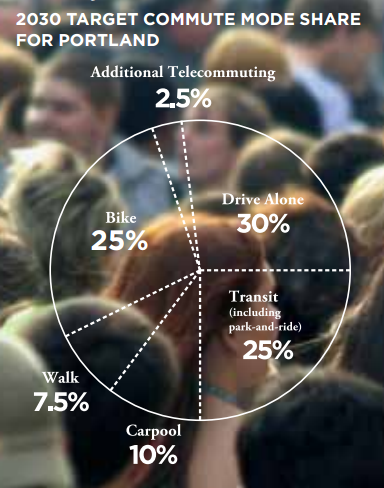
targets of the city’s landmark 2009 Climate Action Plan.
(Image: Bureau of Planning and Sustainability)
On the longer scale, the plan aims for 70 percent of Portlanders to walk, bike, take mass transit, carpool or telecommute to work by 2030. That’d be up from about 30 percent today, a massive turnaround that would reduce drive-alone rates within Portland to those that New York City has today. The goal, which includes a goal of 25 percent of commutes by bike, was first set by the city’s 2009 Climate Action Plan and continues to be included in recent drafts of the 2015 Climate Action Plan update.
PBOT’s new two-year work plan, however, also sets out to divide the bureau’s work into smaller and more clearly achievable goals. It was one of Treat’s first major initiatives after coming into office in 2013 and has been in the works for nearly a year.
She said Tuesday that the plan is written so it can continue to be used as a reference and resource, and presumably to be updated periodically.
The city’s execution of the two-year plan will include regular progress reports on each goal. The document will be divided into one work plan aimed for internal use and another for public consumption; a draft version of the plan is already available on PBOT’s internal computers.
In addition, Treat said the city will unveil a section of its public website displaying “performance dials” (a.k.a. a dashboard) showing the city’s progress toward each of its goals.
“We’re going to lift the curtain,” Treat said Tuesday.


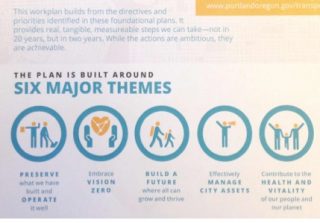
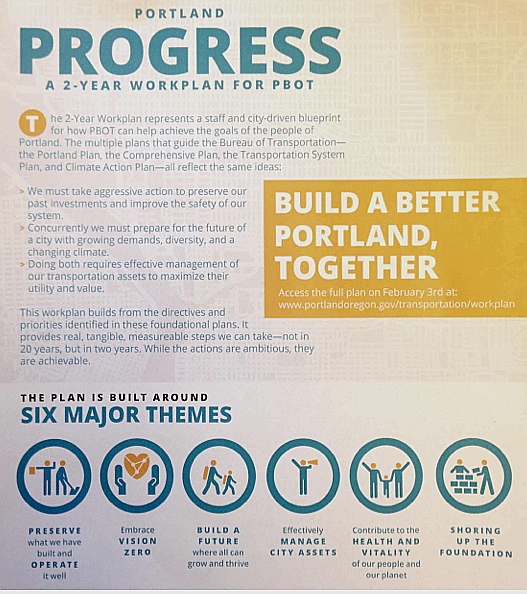
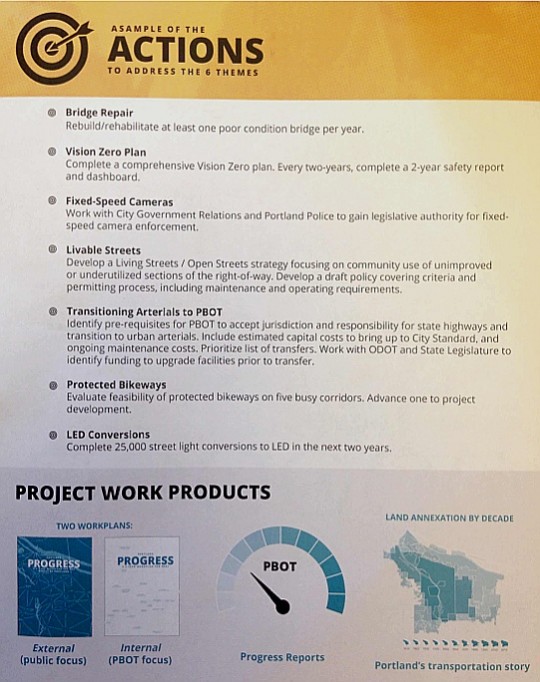

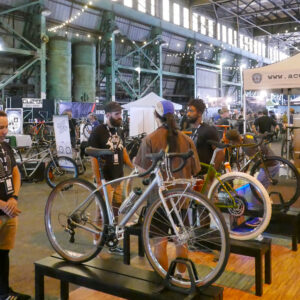

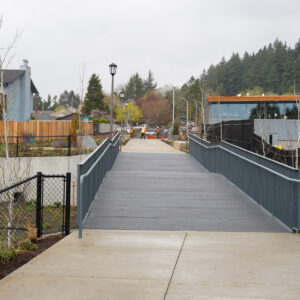
Thanks for reading.
BikePortland has served this community with independent community journalism since 2005. We rely on subscriptions from readers like you to survive. Your financial support is vital in keeping this valuable resource alive and well.
Please subscribe today to strengthen and expand our work.
Wow. A new era for PBOT? Did someone finally read the City’s Climate Action Plan? This is all very encouraging. I hope we can help make this happen.
With the Street Fee out of the way, and all of these tasty morsels featured on the menu, I think I’m going to like this new approach.
Utilizing the public right-of-way means clearing weeds and debris and putting down gravel for urban trails.
There’s more to it than clearing weeds and putting down gravel. This is covered under the draft Community-Initiated Trails Process and is available for public comment through Feb 27.
https://www.portlandoregon.gov/transportation/66082
Key points are:
– Provides a defined process and guidance for developing trails on unused/underused existing right-of-ways.
– All costs of development and ongoing maintenance would be paid for or provided by the community group that wishes to develop it (includes land surveys, engineering drawings, BES permits, etc.).
– Since it’s community driven, some strict (and expensive) requirements such as ADA, can be bypassed. However, the trail would still need to meet PPR “Recreational Trail Type B” standards.
– The approval process requires a variable amount of ROW-adjacent property owner approval (i.e. grants power of veto to a few people over our existing ROW’s), unless the trail is already included in an adopted city plan.
Many people in Arnold Creek in SW Portland have their issues:
http://swtrails.org/right-of-way-on-sw-coronado/
“Protected bikeways: Evaluate feasibility of protected bikeways on five busy corridors. Advance one to project development.”
Why can other cities quickly and efficiently build entire protected bikeway networks in a matter of a couple of years while it takes PBOT two years to “evaluate feasibility” and possibly start planning just one?
Agreed. I want more than this. What’s to evaluate? They work, and they put more bikes on the road (if there’s a complete network). Build them now, and save on consulting dollars!
Do you have examples? For the bike path projects I’ve witnessed in my city, the Environmental Impact Report (EIR) process alone takes nearly two years – and just ask San Francisco what happens when you don’t complete an EIR.
Example please, and of a comparable city with a similar budget. NYC and Chicago would not be two of them. Any very large city with a huge budget where 1% is not noticed but would be a very large number is out. Also, you need a strong Mayor who is behind the plan.
Seattle will build around 14.6 miles of protected bikeways in the next two years, and 32.7 in the next 5 years.
http://www.seattlebikeblog.com/2014/10/20/here-are-the-projects-at-the-top-of-the-citys-bike-plan-to-do-list/bmp-implementation-plan-2015-2019-table/
Pittsburgh built three protected bike lanes in 4 months, and there are plans to build many more:
http://usa.streetsblog.org/2014/11/19/how-pittsburgh-builds-bike-lanes-fast-without-sacrificing-public-consultation/
So, the first thing shown in the PA video was just like SW Broadway. The vertical delineators between two stripes thing, at the other locations, is not a protected cycle track, it’s a buffered bike lane. The vertical plastic poles are just a wider version of the delineators on Hawthorne.
The Seattle link is less clear.
Protected bike lanes have something that more clearly keeps auto traffic from entering the lane than plastic poles.
On the positive side, this might be one of the few concessions actually made to the reality of getting things done in The City That Works.
Decrepit parks are ignored for years unless they are near city hall and the site of protest camp. There’s no budget for traffic calming on Clinton, only for removing volunteer diverters on the very morning they’re placed.
That selective sense of urgency makes it seem like we have politicians running the city bureaus. Oh, that’s right, we do.
“LED conversions: Complete 25,000 street light conversions to LED in the next two years.”
Huge cost savings and better lighting for all road users.
The city should work to replace all city lighting with LEDs. Moreover, a requirement for LED lighting should be written into building codes.
This is super cool in my opinion. I’ve driven and cycled through some of the LED-converted streets recently and I find the light to be a LOT clearer and more natural. I’m also excited to see how many more stars we can see at night in the city once the majority of lights are converted.
Yes, and much less light pollution, as you allude with respect to seeing stars. One outside my home was recently replaced. Before, it beamed straight into my bedroom window an d was a real nuisance. Just by changing the bulb there’s substantially less light going places other than below. Very cool indeed.
I’ve had a very different experience, Gary. I appreciate the change to LED, but these lights aren’t properly shielded and as a result they flood the neighborhood spaces in a much broader way. In my neighborhood, this includes much more light pollution, such that it is more difficult to see stars. (Especially Comet Lovejoy last night!)
I was really excited when Leah Treat took over PBOT, and this plan makes me even more excited for the future.
Glad to see this strategic approach to investment and reporting on progress. It is pretty disappointing to not see a major theme to reduce disparities. Increasing transit and active transportation options for under represented communities seems like a goal that is missing.
I’m very interested to know how they intend to increase bicycle commuting’s share fivefold in fifteen years. It’s plateaued at 6% for these past few years because bicycle infrastructure hasn’t been put in. We’ve gotten a lot of green paint and some arrows in the pretty neighborhoods, but anyone commuting by bike to Swan Island risks their life every day. The main reason people don’t use their bike to commute is because they don’t feel safe. I’m wondering how they will help make it safer or at least feel safer.
I agree! with literally hundreds (maybe over a thousand?) of new apartments getting built and occupied along Interstate Ave from Overlook Blvd and huge new investments on Swan Island, the City really needs to upgrade its bicycle connections between North Portland and the rest of the network. Interstate Ave has well-documented deficiencies of pinch points of the bike lane coupled with excessive motorist lanes (I heard back from the City regarding adding a stripe to define the motorist lane at a consistent 11-feet and received a very disappointing reply that the striping was decided by committee during the yellow line construction). I would LOVE to see the City get serious about this bike connection and upgrade the Larrabee viaduct for heavy vehicles and route ALL motorized traffic up that to access I-5 and the Broadway Bridge. Southbound Interstate Ave could then be closed to motorists between Tillamook and the Larrabee Ave, creating a nice section of MUP. This MUP could be extended to the top of bank between the Broadway and Steel bridges. Eventually, an elevated MUP could be built over the Union Pacific access road and under the Steel Bridge to connect to the Esplanade Ramp. Also, the pathetic west end of the Going Greenway between 7th and Interstate could very simply be fixed by adding protected bike lanes along Skidmore allowing bikes to travel using traffic signals along a simple route.
i’m a “fearless rider” but i find my practical self and the rampant texting speeding and drifting drivers cause me to avoid ALL streets over 25mph. i even use the sidewalk to ride on Holgate off 17th. this approach can work, if Ms. Treat carries a big stick.
If this preview is a good representation of what’s in the plan as a whole, then I love it and wholeheartedly support it. But having heard PBOT say the right things for many years now (the last year or so excepted, as the street fee discussions turned the conversation in a direction that was so, so regressive) and do so little to act on these grandiose visions, I want to see something.
In particular, we’ve been hearing the line about 2030 modal splits for a while now without any meaningful action whatsoever to realize them. I’m glad we’re still embracing those, but I thought they were aspirational back in 2010 and now we’re five years closer to the deadline with no meaningful progress having been made. With no apparent urgency from PBOT on bikeshare, stopping the decline of the greenways, etc., I’m wondering what sorts of silver bullets must be in this plan to achieve these goals.
The whole “performance dial” thing reminds me of a promise Tom Miller made in a speech to the Oregon Active Transportation Summit back in 2012. He said something along the lines of, “Before we get to 25%, we’ve got to get to 10%, and in the coming weeks we’ll unveil our plan to get to 10% and track our progress toward it.” The applause was raucous. The crowd loved it. But neither the plan nor the measurement of pregress ever came to fruition, and in 2015 we’re still where we were in 2012, which is where we were in 2008.
I’m glad that after a year of pretending fixing pot holes is a city’s highest calling, PBOT has returned to saying precisely the right things. But the time has passed for soaring rhetoric. I’m firmly in the “I’ll believe it when I see it” camp.
What’s Step #1, when will we get moving on it, and how can I help?
Hear, hear!
Bold language is welcome, but meaningful actions, clear, ongoing, communication, and results are even more important.
One protected bikeway in two years??? Unless it’s 20 miles long, this seems rather unambitious.
I’ve lowered my expectations so much now that I’ll take one protected bikeway in 2 years.
I’m encouraged – this is so welcome!
I love the concept of a dashboard to keep progress visible, along with a commitment to frequently measure progress against objectives.
Vision Zero/Safe Systems won’t work if the only attack point is road design. Enforcement has to be increased. Adjudication needs to be tougher. PBOT can’t change vehicle standards. The road users need to be supportive, even demanding change, and trained/tested properly. PBOT saying VZ but only working on road design or speed limits won’t get us there.
That is a good point, but, again, you have to start somewhere. I’d take a serious push on road design absent the other pieces over what we’ve been seeing.
Portland has spoiled me to the point where I’m expecting a higher standard. This has some potential, but I want more.
Speed cameras- yeah!